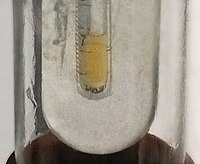
Photo from wikipedia
Modern fluorosurfactants introduced during and after perfluoroalkyl carboxylates/sulfonates phase-out present chemical features designed to facilitate abatement, hence reducing persistence. However, the implications of such features on environmental partitioning and stability… Click to show full abstract
Modern fluorosurfactants introduced during and after perfluoroalkyl carboxylates/sulfonates phase-out present chemical features designed to facilitate abatement, hence reducing persistence. However, the implications of such features on environmental partitioning and stability are yet to be fully appreciated, partly due to experimental difficulties inherent to the handling of their (diluted) aqueous solutions. In this work, rigorous quantum chemistry calculations were carried out in order to provide theoretical insights into the thermodynamics of hydroperfluorosurfactants in aqueous medium. Estimates of acid dissociation constant (pKa), standard reduction potential (E0), and bond dissociation enthalpy (BDE) and free energy (BDFE) were computed for perfluorooctanoic acid (PFOA), 4,8-dioxa-3H-perfluorononanoic acid (DONA) and their anionic forms via ensemble averaging at density functional theory level with implicit solvent models. A ‹pKa› in the neighborhood of zero and a E0 of about 2.2 V were obtained for PFOA. Predictions for the acidic function of DONA compare well with PFOA's, with a pKa of 0.8-1.5 and a E0 of 2.07-2.15 V. Deprotonation thus represents the dominant phenomenon at environmental conditions. Calculations indicate that H-abstraction of the aliphatic proton of DONA by a hydroxyl radical is the thermodynamically favored reaction path in oxidative media, whereas hydrolysis is not a realistic scenario due to the high dissociation constant. Short intramolecular interactions available to the peculiar hydrophobic tail of DONA were also reviewed, and the relevance of the full conformational space of the fluorinated side chain discussed.
Journal Title: Chemosphere
Year Published: 2018
Link to full text (if available)
Share on Social Media: Sign Up to like & get
recommendations!